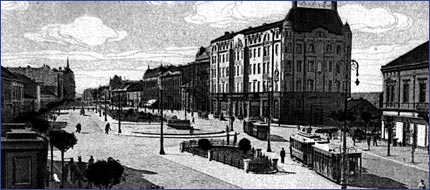
Terazije
Covers an area from Sremska Street to Kralja Milana Street.
Terazije is the most famous square in Belgrade. It started to take shape as an urban feature in the first half of the XIX century. In the 1840s, Prince Miloš Obrenović ordered Serbian craftsmen, especially blacksmiths and coppersmiths, to move out of the old moated town where they had been mixed with the Turkish inhabitants, and build their houses and shops on the place of the present square. Ilija Čarapić (son of Vasa Čarapić), who for a certain period was the president of the Belgrade Municipality, had a special task to assigning lots of land at Terazije to these craftsmen; whoever accepted to fence the lot, would have it for free.
With regard to the origin of the name Terazije, the historian and writer Milan Đ. Milićević noted that "In order to supply Belgrade with water, the Turks built towers at intervals along the water supply system which brought water in from the springs at Mokri Lug. The water was piped up into the towers for the purpose of increasing the pressure, in order to carry it further." One such tower was erected on the location of the present fountain at Terazije and the square was named after it the Turks called their water towers terazije (scales for water).
Up to about 1865, the buildings at Terazije were mainly single and double-storied ones. The water tower was removed in 1860 and replaced by the drinking-fountain, Terazijska česma, which was erected in memory of Prince Miloš. During the first reconstruction of the square in 1911, the fountain was moved to Topčider and moved back again in 1976. This square went under significant changes in 1911-1912, when it was completely re-arranged. Along the central part of the square regular flower beds were placed, and they were surrounded by a low iron fence, while on the side towards today's Nušićeva Street a large fountain was built.
At the end of the XIX and beginning of the XX century, Terazije was the center of social life of Belgrade. The most important hotels, restaurants and shops were located here. Of the important buildings which used to be or still are at Terazije, the "Pariz" Hotel should be mentioned. It was built about 1870 at the place where the "Bezistan" is today. It was demolished during the reconstruction of the square in 1948. The "Kod Zlatnog Krsta" cafe, where the first film was shown on June 6, 1896, was at the place of today' "Dušanov Grad". The old "Kasina" Hotel, built around 1860, was next to the "Pariz" Hotel. At this hotel, in 1918 the National Assembly of Serbia held its meetings for a while. The plays of the National Theatre have been performed here until 1920. The present "Kasina" Hotel was built at the same place in 1922. On this side of Terazije, between the world wars, there were the "Takovo" restaurant and cinema. I danas je na Terazijama hotel "Moskva", sagrađen 1906 u stilu secesije.
In 1936, on the foundations of the old hotel, the new "Balkan" Hotel was built. On the site of a small "Albania" cafe, a palace of the same name was constructed in 1938. The building in which the "Balkan" cinema is today, and in which the "Šiškova kafana" used to be, was finished just before World War II. Terazije acquired its definitive form during its last reconstruction in 1947, when its flower beds, fountain and tram-lines were all removed. In the memory of the five patriots hanged by German fascists at Terazije on August 17, 1941, a monument was erected in 1983 at the corner of Bulevar Kralja Aleksandra and Terazije.

